new posts in all blogs
Viewing: Blog Posts Tagged with: injuries, Most Recent at Top [Help]
Results 1 - 25 of 34
How to use this Page
You are viewing the most recent posts tagged with the words: injuries in the JacketFlap blog reader. What is a tag? Think of a tag as a keyword or category label. Tags can both help you find posts on JacketFlap.com as well as provide an easy way for you to "remember" and classify posts for later recall. Try adding a tag yourself by clicking "Add a tag" below a post's header. Scroll down through the list of Recent Posts in the left column and click on a post title that sounds interesting. You can view all posts from a specific blog by clicking the Blog name in the right column, or you can click a 'More Posts from this Blog' link in any individual post.

By: Shelf-employed,
on 11/17/2014
Blog:
Shelf-employed
(
Login to Add to MyJacketFlap)
JacketFlap tags:
YA,
bullying,
friendship,
school,
book review,
historical fiction,
family life,
J,
abuse,
injuries,
immigrants,
domestic violence,
mental illness,
Communism,
McCarthyism,
Add a tag
 Levine, Kristin. 2014. The Paper Cowboy. New York: Putnam.
Levine, Kristin. 2014. The Paper Cowboy. New York: Putnam.
In the seemingly idyllic, 1950s, town of Downers Grove, Illinois, handsome and popular 12-year-old Tommy Roberts appears to be a typical kid. He lives with his parents, older sister Mary Lou, younger sisters Pinky and Susie, and a devoted family dog. He and his older sister attend Catholic school, his father works for Western Electric, and his mother stays at home with the younger girls.
Amidst the backdrop of the Red Scare and McCarthyism, Tommy's discovery of a Communist newspaper in the town's paper drive truck, and a horrific burn accident to Mary Lou, begin a chain of events that uncovers secrets, truths, and lies in his small town populated with many Eastern European immigrants.
Perhaps the biggest lie is Tommy's own life. Though he never gets caught, Tommy is a bully, picking on kids at school, especially Little Skinny. When he plants the Communist newspaper in a store owned by Little Skinny's immigrant father, he's gone too far - and he knows it. Now it's time to act like his cowboy hero, The Lone Ranger, and make everything right, but where can he turn for help? His mother is "moody" and beats him relentlessly while his father turns a blind eye. His older sister will be hospitalized for months. He has his chores and schoolwork to do, and Mary Lou's paper route, and if Mom's in a mood, he's caretaker for Pinky and Susie as well.
It's hard to understand a bully, even harder to like one, but readers will come to understand Tommy and root for redemption for him and his family. He will find help where he least expects it.
I couldn't tell Mrs. Glazov about the dinner party. Or planting the paper. But maybe I could tell her about taking the candy. Maybe that would help. "There's this boy at school, I said slowly, "Little Skinny."
.....
"I didn't like him. I don't like him. Sometimes, Eddie and I and the choirboys, we tease him."
"Ahh," she said again. "He laugh too?"
I shook my head. I knew what Mary Lou would say. Shame on you, Tommy! Picking on that poor boy. And now she would have scars just like him. How would I feel if someone picked on her?
"What did you do?" Mrs. Glazov asked, her voice soft, like a priest at confession. It surprised me. I'd never heard her sound so gentle.
"I took some candy from him," I admitted.
"You stole it."
I shrugged.
"Ahh."
"It's not my fault! If Mary Lou had been there, I never would have done it!"
Mrs. Glazov laughed. "You don't need sister. You need conscience."
I had the horrible feeling that she was right. I wasn't a cowboy at all. I was an outlaw.
Author Kristin Levine gives credit to her father and many 1950s residents of Downers Grove who shared their personal stories with her for
The Paper Cowboy. Armed with their honesty and openness, she has crafted an intensely personal story that accurately reflects the mores of the 1950s. We seldom have the opportunity (or the desire) to know everything that goes on behind the doors of our neighbors' houses. Levine opens the doors of Downers Grove to reveal alcoholism, mental illness, abuse, disease, sorrow, and loneliness. It is this stark realism that makes the conclusion so satisfying. This is not a breezy read with a tidy and miraculous wrap-up. It is instead, a tribute to community, to ordinary people faced with extraordinary problems, to the human ability to survive and overcome and change.
Give this book to your good readers - the ones who want a book to stay with them a while after they've finished it.
Kristin Levine is also the author of The Lions of Little Rock (2012, Putnam) which I reviewed here.
.jpeg?picon=3498)
By: Cait,
on 9/25/2014
Blog:
Cait's Write...
(
Login to Add to MyJacketFlap)
JacketFlap tags:
tips,
running,
motivation,
art,
goals,
nutrition,
injuries,
training,
cross training,
Add a tag
Within every runner live the Yin Yang twins…the grinder and the ice-cream loving, sloth who lives to watch cartoons. We’ll call the latter the ‘recovery champ’.

While I jest, because it’s not just ice cream they love but pizza, donuts, burritos, french toast [insert runger fantasies here], there is truth to it.
In order to run hard you’ve got to allow your body to recover just as ‘hard.’ It often takes runners awhile to learn this, often the hard way. Typically everyone goes through the stage where they race every run, a run doesn’t count unless you’ve maxed out, right?!  While this usually leads to improvement in the short term, eventually going hard every day will lead down the road of an injured, over-trained, mess.
While this usually leads to improvement in the short term, eventually going hard every day will lead down the road of an injured, over-trained, mess.
Without adequate recovery you’ll be too tired to actually run fast. Easy days are important, as are other ways to speed up your recovery. In order to NAIL the days that count, your hard workouts and races, you’ve got to ensure your muscles are able to rebuild and repair themselves between hard sessions.
So there IS an excuse to laze around in your sweats and hit up a Netflix marathon.  Recovery is more than just an easy day too, for most mortal runners of the world running isn’t your job so lifestyle choices and how you spend the non-running hours of your day will play a big role in your ability to recover.
Recovery is more than just an easy day too, for most mortal runners of the world running isn’t your job so lifestyle choices and how you spend the non-running hours of your day will play a big role in your ability to recover.
Even for the elite runners, they are continually looking for ways to improve their recovery…because chances are there is ALWAYS room for improvement somewhere.
Take a look at your own habits and look for areas you know you could be better at. I’ve made a handy little checklist to give you some ideas of where to start:
* Make sure your easy days COUNT: rely on effort, don’t wear a watch if you have to, you should be able to hold a conversation between breathes on these runs.
* Proper Workout Scheduling: every runner needs to learn their body and how many hard workouts they can handle in a week. As we age we need to learn how to adjust, that may mean turning your ‘week’ into a 10 day cycle.
* Cross Training: I did a whole post HERE about how to maximize training if you know your body can’t handle too many running miles. Cross training on your easy days or as a ‘second run’ can help keep you healthy and allow for an ‘easier’ workout for recovery purposes.
* 30 Minute Refuel: eat a combo of protein and carbs IMMEDIATELY after your runs…especially your hard workouts. Miss this window and recovery rates drop upwards of 60%.
* Nutrition: eating to perform means opting for quality foods, timing them around when you run, and ensuring you get enough nutrients. This means protein, carbs, healthy fats, and overall enough calories to fuel your training demands. Eating to perform also means LIVING, if you’re training hard enough and want a freaking donut, you’ve earned it. Balance comes into play, so I’ll use the analogy of a silo. Fill your body with all the quality nutrients first, then any extra ‘energy demands’ needed to fill the rest of the silo should be up to you. A world without french toast is a dark one.
* Self massage: whole post on that HERE, flush out that lactic acid, keep your body knot-free.
* Hydrate: this is incredibly important regardless of the season, obviously hotter weather requires you to hydrate more and with electrolytes but even in a snow storm you’re losing moisture. Drinking after massage is also important to flush out all that ‘junk’ worked out of your muscles.
* Stretching: tied into self-massage, stay loose, limber, and avoid injuries.
* Time on Your Feet: it’s draining on your legs and energy-zapping, if your job requires you to do lots of ‘work’ know that you may need to adjust your training or learn how it affects you.
* Time on your butt: yea it’s important to rest, BUT office jobs can lead to problems too…too much sitting leads to weak glutes, tight hamstrings, and reduced blood flow. Not good for recovery, so be sure to move around and at least walk around a bit between Netflix marathons.
* Sleep: while I may leave this one for last, this is HUGE!! Sleep is when the body REALLY restores and repairs itself. Skimping on sleep will hamper your recovery, professional runners guard their sleep time and usually take naps too. Make sleep a priority. For those with sleeping problems and insomnia (ugh, join the party!) look for ways to improve the situation or figures out what can sometimes help. Restless nights add up to tired legs and eyebags. 
I think that’s a solid list of ways to improve your recovery habits. Start cracking! To let that grinder perform at it’s best, that recovery-er needs to be doing it’s job right too! 
—–
New ART is listed and available for prints on my page there…restructured to make things a little easier. As always, anything not shown, email me a request and I’ll get you a print.
—-
1) What are some ways you make recovery a priority?

.jpeg?picon=3498)
By: Cait,
on 9/11/2014
Blog:
Cait's Write...
(
Login to Add to MyJacketFlap)
JacketFlap tags:
tips,
running,
shoes,
injuries,
training,
exercises,
strength training,
stretching,
ask me,
Add a tag
I always love getting mail from readers and I often get questions which, because I could talk/write/draw about running all day, I’m always happy to answer. The other awesome thing about bloggy-land and our cyber-culture is constantly making new friends. I enjoy hearing updates back from the runners I’ve ‘met’ after they’ve sent questions and it’s always cool to watch them go on to run healthy and set new PR’s.

Well because great minds think alike, or at least I’m certain questions I’m emailed are ones others probably have, I decided to share a few. If you’ve got a questions feel free to email me at: [email protected]
Without further adieu:
Q: Hi! Do you do your calf strengthening exercises before or after running or on days off? Just curious… I am 45 and returning after a 2 month hiatus. After a 14 day streak (7 @ 20 min and the 7 @ 30 min, my calfs are starting to get cranky)
Do you think everyday is good for us over 40 runners or should I be taking days off?
Thank you so much. Your pages are very helpful?
~ Dan in Portland, OR
A: Hi Dan! Thanks so much for your readership! First off, CONGRATS on finally getting back to running!!
As for your questions: I’d suggest doing the strengthening exercises every other day, but do lots of stretching every day. Always post-run on both of those, for the stretches do the standing wall stretch both standing with your leg straight and and then with a slight bend in the knee, that will work both calf muscles. Also do one with a heel drop, so stand on a stair and just let your heel drop, slowly working deep into that achilles stretch.
As for your running, every single person is different, so it’s a matter of figuring out your running ‘sweet spot’. For now, with being cautious for your cranky calfs, tailor back to 4-5 days and you can totally do some cross training that doesn’t bother it. Then as the calfs calm down, gradually try increasing total time running, be that either running longer OR with added days running. Aim for only increasing 10% total miles each week, then let those calfs be your guide.
Finally, don’t overlook that the body is a whole unit, so be sure to check out if you’ve got other imbalances that could be setting you up for calf pain, and stretch the whole body. Check your biomechanics and you might need some insoles for added support. Also, make sure you’re running in the right shoes and they’re not ‘dead’…you’d be surprised how ‘easy’ things like needing to replace your shoes can totally clear up your symptoms!
Hope that helps, sorry for the novel reply, and say HI to Portland for me…miss that awesome city!
Happy Running!!
Cait
—-
Related Reads:
The Imbalanced Runner: Pinpoint your weaknesses and avoid injuries
The Low Mileage Runner: How to maximize your performance off of low volume
3 Ways Running Can Fly By and 500 Reasons to Update Your Running Shoes

.jpeg?picon=3498)
By: Cait,
on 8/13/2014
Blog:
Cait's Write...
(
Login to Add to MyJacketFlap)
JacketFlap tags:
tips,
running,
motivation,
goals,
injuries,
training,
exercises,
stretching,
cross training,
training tips,
Add a tag
Being patient sucks. Waiting for what we want isn’t fun, but the reality is that often times we are forced to wait. Even more often is it that rushing things will ultimately leave us more frustrated in the long term.
As runners, wouldn’t it be awesome if we could just lace up and make our next race/workout/run a PR? If only, right?! The natural tendency to want those faster times and better fitness TODAY is the breeding ground for injuries, overtraining, and slowed progress. Beautiful irony there, right?

Every runner has been guilty of it, and hey, some things you just have to learn yourself the hard way. (Sometimes a few times to really NAIL that lesson home.) Being patient sucks…but we need to learn to embrace it.
Yikes. Where’s the spoonful of sugar to wash that down? Well that comes when you actually ARE patient and watch your goals materialize…eventually.
The sweetest victories only come after enough struggle and work, after all.
Convincing yourself to wait it out and be patient is tough and often an on-going battle. Incidentally a large part of being able to stay patient comes from confidence. How so?
Being patient means BELIEVING in yourself, what you’re doing, and the process. A runner who lacks confidence is the one who tends to rush things, an example of that is going out way too fast in a race. It takes MORE confidence and patience to go out controlled and then pick up the pace, and close fast. A runner who tries to ‘make a buffer’ by going out too fast is subconsciously affirming they are going to slow down. See how that’s not a good way to think? It takes more confidence to be patience, wait, and then respond to your competitors (or go faster) as the race progresses.
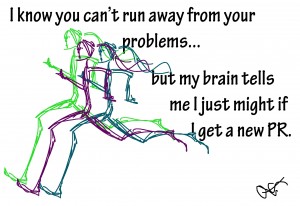
New runners can be a little less than confident in their abilities as they venture into a new sport. That’s natural, but it’s dangerous to go into information overload and want to do EVERYTHING and anything they read about training and incorporate it right away. This usually leaves them injured or too sore/tired that they lose any desire to continue running.
Even if you’ve been a runner for years and years, it’s quite easy to fall into the same trap of wanting to add in XYZ all at the same time…to rush the process. You know what, the same road leads to the same place.
Avoiding injuries and reaching your best takes time. Waiting is hard and it can suck at times, but if you try and rush things too fast it will, in the end, it will suck even more. (nightmares of time off or on the cross trainer missing your race should help keep you patient.  )
)
There really ARE tons of training elements to keep you improving and progressing through the years. This should be exciting news, it’s just imperative not to rush things.
I will say that the BEST way to stay patient and keep yourself honest on the right track (in the moment it can be REALLY hard sometimes to know you need to be patient) is to a have a coach. If not a coach then at least an educated source or training group to bounce things off of. Today it’s important to recognize the source of the training advice you’re getting and if it’s actually got merit.
Being patient can suck in the moment, but eventually it is oh so sweet.
—-
More posts on training tips HERE
Some of those ‘extra’ training elements to help you improve: CORE STRETCHING DRILLS
—-
1) How do you remind yourself to stay patient when you really don’t want to wait?
2) What keeps you honest/patient when it comes to your training?
3) When is an instance where NOT being patient made things much worse for you?

Running is all about dealing with discomfort. It teaches us that we are capable of handling more discomfort than we think and it always increases our tolerance for pain discomfort.
Running strengthens us and skews our perception of just what is uncomfortable.

A non-runner complains about a stomach ache, a runner doesn’t start complaining until they are projectile vomiting. But the reason that runner’s complaining is probably because it’s in the middle of a long run and they NEED to keep that gel/drink down because they need the energy, not because it hurts. 
Pushing ourselves outside of our comfort zone is the only way to keep growing as a person, as an athlete, as a runner. In FORCING yourself to push, you’re setting yourself up to achieve more. The beautiful thing is that whether you wind up hitting XXX goal or not (if there’s not the danger of failing then you’re not setting high enough goals!) you’ll no doubt have improved in some way. You’ll have made progress.
The journey to progress is just as important as the end results.
Now I said it was a beautiful thing, fancy that, discomfort being beautiful. It may yield beauty but living through it is hard, painful, grueling at times.
Discomfort tests us. But when you open yourself UP to that feeling of discomfort you’ll discover that it DOES get easier. And you’ll be inching your threshold to withstand discomfort ever forward.
Running teaches us so much about life, and one of the strongest lessons is that, yes, we are much more resilient and tough than our minds want us to believe.
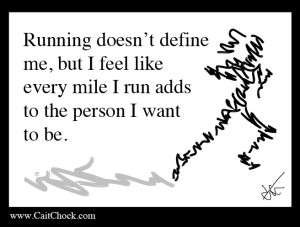
It’s a coping mechanism, our brains don’t really like feeling uncomfortable. So we have to just trick it, PUSH, and force it to keep going.
Pushing yourself to step outside your comfort level in running can be achieve in a myriad of ways outside of hard workouts. Test your range and set your sights on a short and fast 5k instead of a marathon. Improve your flexibility and REALLY start stretching, build your neuromuscular system to be more responsive and reactive with drills. All of the above may leave you feeling awkward, out of place, frustrated even…but that’s good. Stick with it and eventually things will get less uncomfortable.
You’ll wind up getting faster and becoming a more balance, performance-driven runner.
Apply that to life. Learn a new skill, be prepared to feel like a total idiot at first and BE OKAY with it. A runner’s natural tendency is to want to be the best, but you have to start somewhere. Be CONFIDENT enough to accept you very well may suck, and be SECURE enough to ask for help. Ask others to teach you. Then learn.
Finally, life and running will test you in ways you didn’t actively seek out. You’ll be pushED rather than be the one pushing. That’s scarier because you feel out of control on top of it. But you know what, discomfort is discomfort and the same rules apply.
Know that you are stronger than you are wont to believe. Embrace the discomfort and keep moving forward. You will survive, progress will come.
And at the end of the day you have the peace of mind in knowing, “I can handle it, I’m a runner for crying out loud!”
I challenge you: How will you step out of your comfort level?

.jpeg?picon=3498)
By: Cait,
on 8/4/2014
Blog:
Cait's Write...
(
Login to Add to MyJacketFlap)
JacketFlap tags:
tips,
running,
motivation,
injuries,
training,
stretching,
core,
recovery treatments,
cross training,
Add a tag
Nothing unites complete strangers more than discovering they are both, in fact, injured runners. Because let’s be honest, no one REALLY understands the agony us runners go through when we’re deprived of our ‘fix’. Miles give us endorphins, take those out of the equation and you do the math. It sucks.
Run long enough and you’ll get injured. It’s a fact. Darn these humanoid bodies not quite engineered to put up with everything we want them to do in training and racing. This isn’t to say there aren’t plenty of ways we can limit our injuries, and yes, us runners can be quite stupid sometimes in getting ourselves injured, but at a certain point you will get injured despite doing everything you can do right.

But don’t think of that last line as a free pass to just go willy nilly, throw all caution to the wind then, when you do wind up hurt, pretend you have no clue why. Let’s start with the stupid:
• Denial: Oh we’re the queens and kings of denial, us runners. “It’s not really that bad, it doesn’t hurt that much” thought as we hobble around the house in search of more ice.
• Grimace Face: We know running hurts, but when every stride sends a shooting pain (which you’re of course denying exists) your face gets twisted into a grimace that would make Frankenstein look beautiful.
• Random Prayers: You go to bed praying you’ll wake up and magically everything will just go away. No other logic there but a runner clinging to any shred of hope.
• Eff It, I Can Finish: Said during any run or workout, you’ve denied the shooting pains for as long as possible, somehow still believing that if you just muster on through this run, get done, things will still be peachy keen.
Clearly we all have to learn from our stupid mistakes. We’ve all been there, hopefully the older we get the wiser we get. Because let’s be honest, denial doesn’t change the situation.
Over the stupid, here are the proactive:
• Self-massage: Runners if you’re not in a love/hate relationship with your foam roller, I urge you to get cozy with it. Give him or her a name even.
• Stretch: Static and dynamic stretching post run.
• Core and Strength: Strengthening your core and WHOLE body to limit the compensation issues resulting from weak muscle groups.
• Ice, Smart, Recovery, Etc: You know the drill there.
• Form Work: Ties right into strength, run more efficiently and you’ll be doing less wear and tear on your body.
I’d like to take a minute to emphasize that if you’re not doing some kind of core or strengthening routine you’re not addressing issues that WILL eventually get you injured. Not a single runner in the world pops out perfectly balanced and with perfect biomechanics. Most runners have tight hips and weak glutes, just two major issues that cause many a runner heartache come injury time. What’s more is there tends to be a little too much emphasis on stretching alone. YES you need to stretch, but save some of that time for core work because you can’t stretch away a weak muscle group if you get my gist. I’m not talking about hitting the weight room like a Jersey Shore’r (a little dated reference but I was watching a comedy earlier that did a bit on that so it’s on my mind), and in fact many of the most effective exercises for runners can be done with bodyweight or with a swiss ball. I did some posts HERE with some of those.
Crash Course: Mentally Surviving an Injury
Back on topic. So you do your preventative but like I said injuries will occur. When you’re laid up you’ll most likely experience a few emotions.
• Rage: Like wanting to literally rip off your leg just so you can smash it against a wall, infuriated that ‘it’ let you down.
• Remorse: I abstain from the word depression, but it’s like a hair away.
• Anxiety: Is this going to EVER end? Will I EVER be able to run without pain, ever? Getting up in the middle of the night to go to the bathroom and you sorta ‘test’ jog down the hall, “Crap! Still hurts!”
• Envy: Oh that lovely runner envy. Daydreaming about hopping out of your car and slapping in the face the person you see running down the street. It’s not something to be proud of, but every injured runner thinks it. 
• Rage: Yea, you circle on back to rage.
I blame it on the lack of ‘proper’ endorphins for our crazy train ride of emotions and THESE are the things that our family and friends tend to have a hard time grappling with. To every runner who’s gotten, “But it’s just running” and you have to literally hold your arm down from punching that person in the face…yea, that’s a normal runner reaction.
The thing is, while I like to joke and jest and be comedic about Runner Rage (it’s totally legit and an excuse that I think should hold up in court, “Sorry, I’m not fully in control of my actions, I’m a runner who’s not able to run at the moment”) I’m also the first person to say this:
“Force that positivity down. Choke it down and keep it there. Fake it.”
Yup! That’s the only way to get through an injury. You keep yourself OUT of that depressive and overly-anxious mindset because if you don’t you’ll stay right there…stuck.
How I deal with Runner Rage is making fun of myself and being sarcastic. Rather be laughing than wallowing in sadness. What also helps is to feel proactive during your recovery meaning: cross train, core, massage, find out where your weaknesses are and target them. Come up with a recovery plan and start the execution. The other really important thing is:
Take it ONE day at a time.
Think only through the day. Because thinking of weeks and weeks of the elliptical or bike is, well, depressing, right? So just get through the day.
And there is always this: you’re not alone. There are other injured runners out there. And there are non-injured runners who know EXACTLY how you feel and what you’re going through and they sympathize and are sending you heal up fast vibes!

The last few days my Adobe was acting up, legit like a two year old heck bent on crippling me. I couldn’t finish work that NEEDED to be done, I cursed the computer and slammed some fists. It had turned ME into a toddler. Hot mess.
Stress. Frustration. Anxiety. We can’t avoid it in life and we can’t avoid it in running either. There are ALWAYS going to be things totally out of our control. My tantrum wasn’t going to solve the computer issues, and neither is the wildest of fits going to cure a stress fracture. Sometimes sh*t just sucks but you NEED to deal.
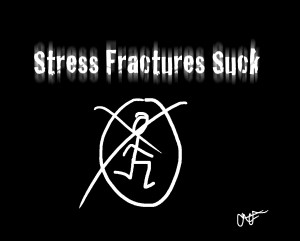
In the moment that can feel impossible but our fast-paced lives have gotten to a point where the stress, anxiety, and frustrations churning through us are destroying us. Making us sick. Clearly even if you’re not on the verge of a stress induced heart-attack or breakdown, I dare say everyone and anyone has some sh*t going on that they would do well to unburden themselves with.
What do I mean by unburdening? You most likely can’t take away or change every situation, you can’t make money float down upon you or force so-and-so to get back to you with a quote that you NEED because your article deadline is hours away.
Unburdening can be more like shifting how YOU are dealing with the situation. Adjust and learn to let go. I’m sum it up:
Do EVERY single thing you can to control the situation and make it work how you’d like it to…from there, heed to the ‘que sera, sera’.
Injury?
You get hurt, injuries come with the territory in running. Do what you can to reduce your risk but you can’t avoid them. Here are your three steps:
1) Throw your dang tantrum. You deserve it. But put a time limit on your baby breakdown. Ten minutes, a day max.
2) Get proactive. Shift to problem-solver mode (logic and reason side of the brain, move out of emotional/reactive side). Come up with a cross training and rehab routine.
3) Do it. Move through that routine and ONLY take it a day at a time. Don’t dwell on XXX weeks or months. Look at your rehab like taking your medicine…spoon full of sugar that crap down. 
Bad Race or Workout
Also comes with the territory in running. Ironically the steps are eerily the same as above:
1) Mild upset is allowed. You deserve to be disappointed and that’s the same feeling that will motivate you to work harder next time. But don’t be a pouter, don’t be one of those jerks who ruins everyone else’s workout/race/day/etc. Cry on the inside like a champ. Haha.
2) Get proactive. Learn anything you can from the experience, is there a reason it was bad? Reassess your training if need be.
3) Move on. Keep on trucking. Some days your legs just don’t show up for whatever reason. Learn what you can the move forward.
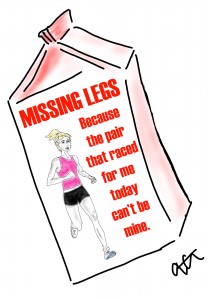
Never let a bad workout or race turn you into a pessimist. That kind of perspective is what kills peoples’ passion and could ruin your love of running. No one wants that.
All that stress and anxiety [psst...don't get too nervous before races either, here's my post on that.] only makes things more of an uphill battle for you. So don’t make things worse on yourself. Unburden that sh*t.
Ironically, the more balanced and less stress you put on yourself in running the better you end up performing. There’s a little thing called over-thinking, My Friends.
Back to life because 99.9% of us aren’t running for our jobs. Which means our jobs and life events are brining us the most stress. [that extra stress will effect our running too...so if you're also wanting to run better you'll do well to unburden some life stress...logic holds there. Haha] But far too many of us let things that shouldn’t stress us out THAT much, well, stress us out THAT much.
I challenge you to let go of some little things. Lots of those things include wondering what someone else thinks about you OR complaining about someone else. A tip there, years ago I adopted the thing of not saying anything about someone else that I wouldn’t just say right to them. I’m a straight-shooter so rather than complain, isn’t it better to just go to the source and [strategically] say whatever you need to? Problem solved there.
Now for the curveballs and bigger things life will deal you often, we’ll circle back to what I suggested we do in running. Hey, like I say EVERYTHING circles back to running, right?! 
1) Baby tantrums. You can be entitled to a fist pound on the laptop but put a time limit on yourself.
2) Proactive mode. Do EVERYTHING you can to set yourself for the best outcome.
3) Move the heck on. You can’t control lots of things in life, namely other people. So…”let it go.” 

Stress makes you unhappy, it will also make your running harder. All the more reason to unburden some of that crap!
1) What is one little thing you’re going to unburden yourself with TODAY?
2) How do you handle BIG life stress?
3) Do you consider yourself a highly stressed and anxious person?

Because let’s be honest, running withdrawals hurt a h*ll of a lot more than the injury.
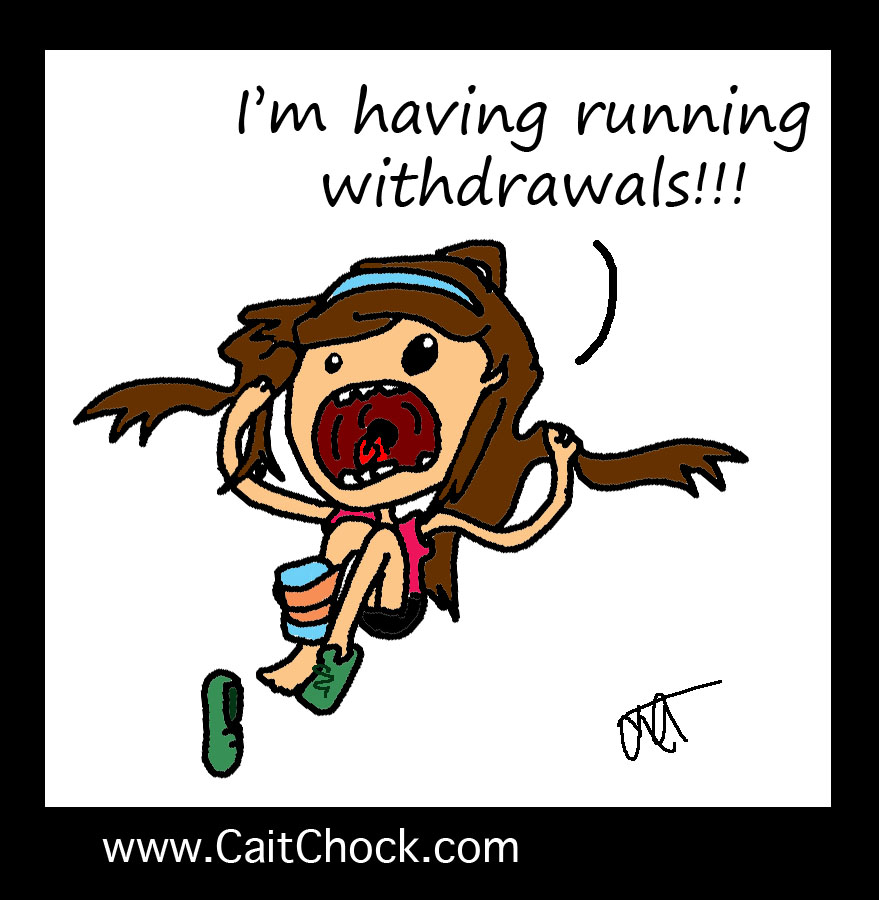
For all those healthy enough to run…be THANKFUL. Never forget that, on the days you really aren’t jazzed to suit up and start, put it in perspective. Would you rather be chained to the cross trainer?
Our runner hearts go out to all the currently injured runners…we’ll donate some miles on your behalf. Heal up, cross train like you mean it, and you’ll be back at it again in time. Don’t go mad until then though!
——
Posts all about Running and Injures
More Motivation for Runners
Even runners going through withdrawals can at least LOOK runnerchick chic in an Ezzere Tee!!
Tips for Cross Training
——

A headline caught my eye recently: “Be a better runner without running.” *About face* Now I respect the news outlet that ran the article but the snark in me can’t resist thinking, “This kind of thing belongs in Runner’s World next to the column ‘How to get faster in your sleep!’”

Track dreams…but you still need to actually run on the track too. ;)
In seriousness though, yes there are ways to improve your running and get faster that aren’t running. HOWEVER, these are thought of
like ‘extras’…you still have to run.
Everybody and every BODY handles a different amount of volume and quality. Not everyone can log 110 miles per week, with a hard speed session, endurance session, and long run in a 7 day cycle. Some people can run 170 miles per week just fine, others get hurt going over 50…waaah-waahh it’s not fair but that’s how it is.
Know your body. Know your limits and maximize them. Just because you can’t RUN more than 50 miles per week does not necessarily mean you can’t beat the runner doing twice your volume. Enter QUALITY.
Here are a few quick tips on maximizing your training if you’re a runner who is a little more ‘fragile’: (ie: improving your running with running less and doing other stuff)
* Extend Your ‘Week’: By this I’m talking about viewing your training cycle as 9-10 days rather than the standard 7. Meb Keflezighi has talked about doing this as he’s aged, and many masters runners work off of a longer training week. This allows for more recovery between hard workouts.
* Rule of 10 and Baby Steps: If you’re injury-prone already you know you need to BABY your body a bit. Only increase your miles by 10% each week. Then be honest with what your mileage ‘max’ is. If you start getting extra creaking when you kiss 50, stick there and supplement with extra cross training instead of miles.

* Swap Your Easy Runs: Plan your miles for the week and ‘save’ them for your hard workouts and long runs. Those are the days that will give you the most bang for your mileage buck. Cross train on the easy days; to be honest the benefit of easy days are mostly just getting the steady cardio in…you can do that running or cross training. The former is just a lot easier on your body.
* Seek Soft Surfaces: The pavement is harder on your body than the trails, track, and treadmill. Seek these softer surfaces. Also know that lots of downhill running exponentially increases the impact on your joints, so steer clear of huge, sharp downhills.
* Get More Efficient: Most injuries are a result of a weakness and muscle imbalance. Fix those and you’ll be running more efficient and most likely be able to handle running more. All the more reason to fix your form, get a stronger core, and solve why you might be stuck in a vicious cycle of injuries.
* Fitter With Cross Training: Ideally you want to be doing your hard workouts as running because this will translate the best for racing but you’d be amazed by how fit you can stay with cross training workouts. So if you have to do some of your ‘running’ workouts on the cross trainer don’t freak out and remember it all comes back to effort. Go hard, get your heart rate up, feel the burn in your legs and lungs, and you’re getting work done.
Not EVERYTHING that will get you faster comes from running more miles. Think outside the box, learn your body, and maximize your potential.
Though the snark in me still has to end with this: “but, duh, you still have to do some running.” 
——-
More articles on cross training and workout ideas!
More articles on injuries, recovering, and how to prevent them!

A friend of mine was asking his runner friends what their favorite training tracker or log was. Apps, watches, etc. were all thrown out there. Personally I don’t use any of the online training upload apps or sites, not that I have anything against them, I just have a love/hate relationship and here’s why.
1) What are you comparing?
Now I’m OCD and I know that about myself. I abstained from buying a Garmin for so long because I can easily turn it into an ugly thing with knowing too many numbers. I know that about myself. But I also know the watch can be a great tool to use. So I bought it and learned how I can ‘safely and sanely’ use it. And yea, I flipping love it.

But I don’t upload stats and pour over the elevation charts, I don’t wear a heart rate monitor I go off of effort, I don’t want to feel like a scientist about my runs. But that’s just ME. Of course hard workout splits I do care much more about, but I don’t look at the splits on my easy days.
But some people LOVE all the stats…that’s cool beans, that’s why they make all those things! I just caution you to compare what matters and what can actually be destructive.
* Fast Hard Workout Splits Matter.
* Fast Easy Run Splits Work Against you.
Make sure you’re able to recover on your easy days so you can NAIL those hard days. Those are what count.
2) Competition for the sake of competition?
Lots of runners are Type-A, a bit OCD, and of course competitive. Now there are things to be competitive about: races, PR’s, etc…but then there are other things that are just dumb and destructive.
If you’re trying to do XXX amount of miles because you want to beat Joe Moe’s total miles at MilesTrackerMadness.com (just pulled that outta my head, not a real site??) then you could wind up injured or overtrained.
They don’t give PR’s or medals to people in training, what matters should be race day. If you’re feeling sucked into wanting to do more for the sake of just doing more stop and ask yourself this:
“What’s in the best interest of my long term running goals?”
Btw…who knows if Joe Moe is even being truthful?
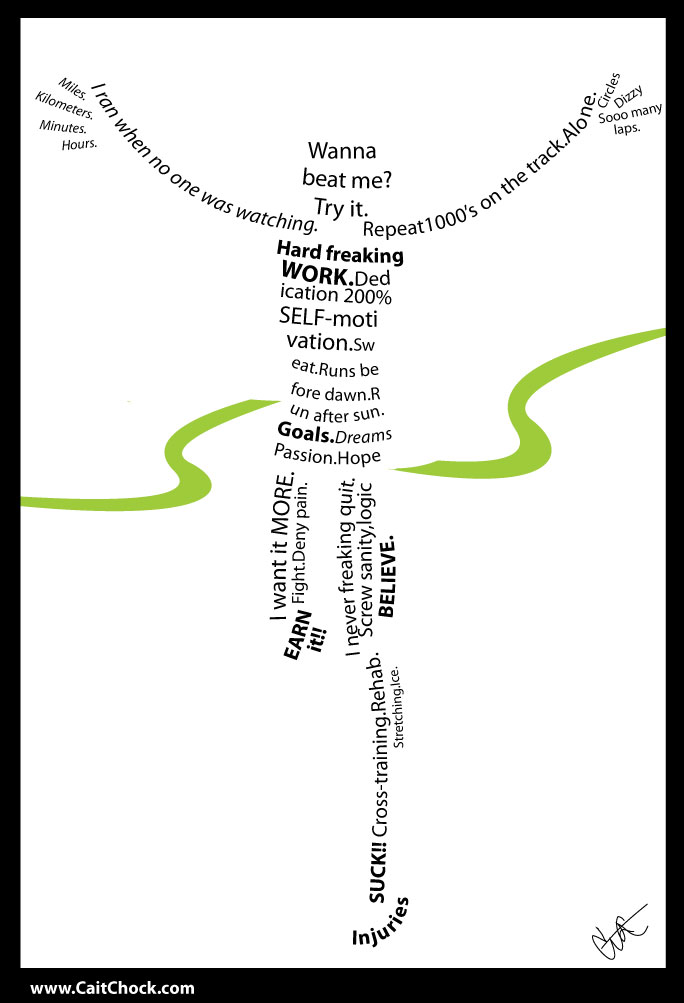
3) Motivation versus Pessimistic attitude
Most runners are motivated when they see incredible feats like Meb winning the Boston Marathon!! Hurrah!! But thinking on a more logical scale, seeing what people are doing who are closer to your fitness level, running pace, or age can be just as motivating. If you’ve run with someone and trained frequently with them, if you know you can keep pace with them in a workout and you see they raced XXX you should be feeling quite confident that you, yourself have the ability to race XXX.
The problem is when runners come down with the wrong perspective…namely a pessimistic one. “What the heck, Meb can run a whole marathon faster than I can run a half! Why am I even bothering?!” That’s really just an excuse your brain has for wanting to be lazy and not try at all. 
You will probably never beat Meb…yo, honesty policy. But you shouldn’t be comparing yourself to Meb unless you’re on ‘that level’. The motivation of elite runners should come in the way of:
* Running hurts for everyone. The test is pushing YOUR limits.
* Running is fun. If you’re not keeping it that way then that’s sad and find something you are passionate about.
* Compete agains yourself. PR’s are called PERSONAL Records. You set a new one and THAT is something to be proud as heck about.
Keep things in perspective and realize what you SHOULD be comparing your running to and what you shouldn’t. Use any App or community training forum as the positive it can be: a motivating space for people to stay on track and dedicated to their goals.
Emphasis on THEIR…ahem…YOUR GOALS. 

.jpeg?picon=3498)
By: Cait,
on 3/27/2014
Blog:
Cait's Write...
(
Login to Add to MyJacketFlap)
JacketFlap tags:
tips,
food,
running,
Cartoons,
motivation,
blogs,
injuries,
training,
core,
Add a tag
Let the #CoreandCake Party get going, Runners!  I’m going to start by showing you a quick core routine that you can do post-run. It’s short and sweet but effective at hitting those important core muscles, so there’s NO excuse for not doing it because you can whip it out fast.
I’m going to start by showing you a quick core routine that you can do post-run. It’s short and sweet but effective at hitting those important core muscles, so there’s NO excuse for not doing it because you can whip it out fast.
I’ve got some picture demonstrations for a few of the ones that might be trickier to explain. Truth: I actually did a video but I think I’ve already grown tired of my chipmunk voice, so opted for the stills. 
Here’s how it works, there are group of exercises. Work up to doing three sets of each group, do all the sets for each group before moving onto the next group. Try doing this (or at least SOME core work) three days a week.
Group A
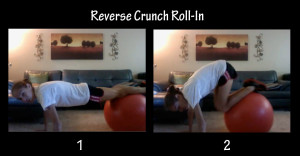
1) Reverse Crunch Roll-In’s — Set of 16
2) Ball Crunch — Set of 30
*Note: for the middle set, I like to mix it up and do the crunches alternating side to side.
Group B
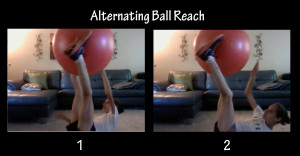
1) Alternating Ball Reach — Set of 30
* Alternate reaching opposite hand to opposite foot; 30 total, so 15 each side
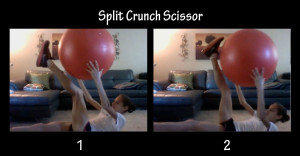
2) Split Crunch Scissors — Set of 16
* Start laying flat, as you reach up to center with the ball bring your left leg up towards the ball. Lower back down then bring your right foot up to the ball. Repeat.
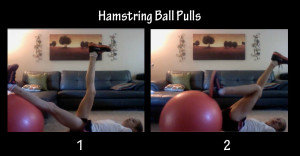
3) Hamstring Ball Pulls — Set of 8 for each leg
* This move works in three phases, and similar to the BRIDGE EXERCISE DEMO I did but up on the ball. Start with one foot on the ball and back flat on the ground, lift your butt up so you’re doing a bridge on the ball, then roll/pull the ball in towards you. Roll out, lower your back down to the ground out of bridge, then repeat. Then switch to other leg.
Group C
1) Push-up — Set of 10-15 (Modify on your knees if you have to.)
2) Chair Dips — Set of 10
BAM!! You can’t tell me you can’t bust that out in 10-15 minutes at most. But the benefits to your running are incredibly important:
* Strong Core = Efficiency. Build up your core and ‘weaker’ muscles so you’re able to hold better form as you run. Maintaing proper form, even as you tire, will keep you more efficient…read as faster.
* Strong Core = Less Injuries. You got it, most injuries are a result of an imbalance that result from a weak muscle. Fix those so you don’t wind up injured and not running at all.
Oh wait, we forgot the OTHER major benefit, you do your core and you get cake too! 
#CoreandCake Party Phase 2…

Nom.

Nom.

Cake sees no speed. Runners of ALL levels working hard get their cake! ;)
Nom.

Nom….check it out, #coreandcake goes #SweatsintheCity style in my
Ezzere Run Your Fortune Tee!!
Check out the AWESOME Lisa @ RunningOutofWine because she’s celebrating all the #coreandcake goodness over at her blog too!! 
Thanks all your runnerchicks and runnerdudes for coming, now go get YOUR #coreandcake on too! Don’t forget you can tweet/insta/social media #coreandcake all day, seeing hardworking runners devouring their just desserts always makes me smile. 
1) How often do you incorporate core work into your routine?
2) What’s your favorite kind of cake, or any dessert?
3) Have you partied down with Lisa yet too?? If not…you best head on over NOW!! 

A runner’s mind is filled with lies. We live in our own sort of warped reality. I’ve talked a lot about how lies are our little coping mechanism so we CAN stay dedicated and motivated to keep reaching our goals. That lies can be a good thing.
The thing is though, not all of those lies are created equal and it’s important to know which lies you should be ‘believing’ and when you need to be truthful.

Good Lies
* Midway through a workout: “I’m only doing 1 more repeat, don’t worry brain!”
* About to start a workout or at the starting line: “It won’t really hurt, I swear!”
* In moments of motivation lulls to just START running: “Just run for 5 minutes, if you want to stop then you can.
These are the lies that help us tune out the pain and call our brains out when they’re just being lazy. These are AWESOME lies and the ones you should be blasting from a megaphone because they’re coming from your inner rockstar runner. The runner who wants you to achiever your goals…believe everything they say, those lies will fuel your greatness.
Bad Lies
* Mid-workout brain chatter: “You can’t keep this pace up.”
* Starting line: “Holy crap, I don’t belong next to so-and-so, they’re going to kick my butt!”
* Mid-race: “They just surged, they must feel way stronger than me…I’m just going to let them go.”
These are all the things that weak, insecure, tired, lazy, annoying, complaining brain likes to shout at you. These are remarks your rockstar runner persona needs to refute and call-out as lies. “I am stronger than I think. I belong at this starting line. A race isn’t over until the finish line and I know they hurting too, I just need to hang onto them.”
Dangerous Lies
* Mid-workout: “What was that POP? I’m sure it’s nothing…I think this pain will just go away in a second…”
* After 6+ days of feeling like total sh*t and workout times getting progressively slower: “Just suck it up…I’m DOING this long run/workout exactly as was planned 4 months ago.”
* In life: “It’s totally okay that I’ve only slept 4 hours the last five nights and been existing on Sugar Daddies, Ramen noodles and Diet Coke.”
You get a runner, heck-bent on proving their toughness and combine that with our own ‘stupidity’ (“It doesn’t hurt THAT bad, I can surely make it three more repeats!”) and that’s when things get ugly. Injuries, Baby, injuries. Runners are always riding a fine line between good pain, bad pain, when to push, when to ease back, and to our credit it CAN be incredibly difficult to distinguish ‘right pain’ from ‘wrong pain’ and from there the degree of ‘wrongness’. I’m sure that reads like jargon to normal people, but runners totally GET exactly what I’m talking about.
The thing is, runners usually have to just learn the hard way and suffer through times when they’ve made mistakes to LEARN. Eventually you’ll come to find it’s better to err on the side of caution. It doesn’t make you mentally weak or a lame-o runner; in fact it takes more self control and confidence to hold back and issue that self-restraint.
Think of it this way. You’re running and mid-workout you definitely know something is off.
Option 1: Either slow down to a pace where you don’t feel the ‘bad’ pain or pull the plug on the workout entirely. Follow it up with some easy days and you’ll be right back into training mode after.
Option 2: Grit your teeth, finish the workout come h*ll or high water. You limp through a cool-down and the grimace never leaves your face. You ice like a mofo the rest of the day, chomp Ibuprofen like they’re Smarites and pray you’ll somehow go to bed and miraculously be fine.
What scenario do you think wins out?? Finally, what’s the WORST thing that could happen if for some reason you could have finished the workout and been fine after? The running police won’t come and yell, “SLACKER!!” at you.
Just keep working hard and remember training works on the law of averages, that single workout isn’t going to ruin your entire build-up to your Championship race.
Why it’s Hard to Admit a Dangerous Lie is Reality
On the flip side, runners sometimes grit their teeth through the ‘bad pain’ because they are afraid that if they stop they’re going to lose the ability to PUSH through the ‘right pain’. I know you know what I’m talking about because it feeds right back into the GOOD kind of lies.
Running hurts one way or another whether you’re injured or not. You can’t let your mind actively be looking for excuses to stop. So naturally there is the fear that if you pull the plug on a workout one time, you’ll start a chain reaction that results in you never being able to finish a workout. This does happen, and it’s mental suicide for a runner but here’s the thing…
…it works on a case by case basis and for lots of runners this fear of ‘losing the ability to push through pain’ is irrational. So, be honest here…you DO know good pain from bad pain, you DO know you can push through good pain, so in those pinnacle moments of needing to decide if you need to stop or not, listen to your gut.

If your bones tell you you’re in danger of really doing damage, stop. It’s not worth it. You can’t run at ALL if you’re injured.
The same goes for a runner who refuses to acknowledge they need to ease back and give their body some rest rather than keep pushing, and keep digging themselves into a hole. Again, all those fine lines, but if you’re experiencing chronic fatigue for a week or more, you need to adjust.
Training routines aren’t concrete and always need a degree of flexibility. Flexibility goes both ways, sometimes you need to push yourself harder but other times you need to know when to scale back.
Don’t dig a hole so deep you have to take a full-on break. Sometimes a few easy days will do the trick and breathe life back into those legs!
Wow, so many lies!! You see why I said we live in a warped runner reality, no?! But be smart.
Tune into the good lies and believe them with all of your heart. Then be secure and confident enough in yourself to recognize the bad lies for what they are and face the real truth.
——-
More posts on CONFIDENCE
More posts on MENTAL TOUGHNESS
More posts on INJURIES
——-
1) What’s a good lie?
2) What’s a bad lie?
3) What’s a dangerous lie?

.jpeg?picon=3498)
By: Cait,
on 3/20/2014
Blog:
Cait's Write...
(
Login to Add to MyJacketFlap)
JacketFlap tags:
tips,
running,
videos,
injuries,
training,
exercises,
workouts,
strength training,
core,
Add a tag
Alright, Runners, time to tell you the brutal honesty about your hamstrings: they’re plotting against you! They’re weak, they’re tight, and they’re cranky! Okay, okay, I’m speaking in the general, so your personal hamstrings (if you’re ALREADY taking care of them properly), may not be secretly plotting away an injury for you in the future…but it’s an ongoing offense we must play.
Hamstrings rank among one of the TOP injuries, or underlying issue for an injury for runners. The reason? Partially our lifestyles with too much sitting and also because runners are just prone to tight and weak hamstrings. The solution? Be proactive!
I’ve put together a video demonstrating an exercise routine targeting those weak hamstrings (and glutes). It hinges on the bridge exercise, doing them as single leg bridges. Aim to do these three times a week after your run, it will literally take you a minute or two, so no excuses!
3 Way Single Leg Bridges
10 raises each leg
3 Different distances from glutes
Avoiding an injury that keeps you from running is an ongoing effort, being proactive in the stretching and core work is your two-pronged approach! These nice exercises are one part of the puzzle and the other is doing the stretching.
Do yourself and the rest of the world a favor and keep being proactive…an injured runner on the streets is NOT someone I’d like to cross. 
———–
Fun announcement! If you follow me on Twitter you may have caught wind of #coreandcake parties that have been going on. It’s simple, do you core and you get your cake! Runners are human, we work well off of bribes. 
I’d like to take this party to the blog world! SOOO…I’m having a #coreandcake party NEXT Friday, March 28th and EVERYONE’S invited!! Here’s what’s going down and how you can take part:
1) I’ll be posting a core routine I’m currently loving, followed of course by talk of cake!
2) BLOGGERS: This will be a link-up sort of deal, so if you email me: [email protected] with an RSVP that you’ll also be talking core and/or cake on your blog we’ll kindly link up.
3) Social Media: If you’re tweeting, FB’ing, or Instagraming on that Friday let’s bust out that #coreandcake hashtag and give me a shout-out…cuz, let’s be honest, I can’t get enough of seeing core and cake taking over the net. 
So this is your INVITE!! 
———
1) What is one of the ways you proactively take care of your hamstrings?
2) What is one of your known weak spots as a runner that you give extra care to?
3) What’s your favorite kind of cake?
Ummm….chocolate….duh! 

I’m a runner, I’m injured, I’m not held accountable for my actions.

I’m pretty sure this would hold up in court. A runner deprived of their endorphins isn’t quite themselves. Be warned, handle their delicate psyche with care…
———-
Staying POSITIVE through an injury is the only way to get through it…my post HERE is all about that.
More post ALL about INJURIES
Posts for CROSS-TRAINING (trust me, cross-train while you’re injured so you can come back to running stronger! doing nothing will be a cold slap of reality…take some of the sting out.  )
)
When not injured, sometimes you need to remind yourself how lucky you are. Don’t take your running for granted.
———-
1) The last time you were injured, what was a ‘casualty’ of war?
I may or may not have bitten a few heads off. 
2) If you’re injured right now, you’re allowed one vent sentence. Then follow it up with a positive affirmation that will get you through your injury.
3) For all you NOT injured, write a sentence on how you’re GRATEFUL for your ability to run and remind yourself never to take that for granted.

For once my running cartoons will be used and I’m deathly serious. Stretching, Runners, is no joke. I used to HATE stretching, I’d do it begrudgingly, but ever since my little revelation in Boulder I’ve pulled a total 180.
Now it’s good too because I don’t have a little bit of guilt writing about and telling runners just how crucial stretching is. I’m practicing what I preach, yo.
Areas that rank most common across the board for running injuries and the areas that runners are notoriously tight in are: the hamstrings, glutes, hips and groin region, and the psoas. I took my cartoons and put together a quick stretching routine that you REALLY should be doing as much as possible. Like daily…I’m doing them daily, so now I can say, fully absolved of any lingering guilt, that you should do the same. 
[Click to enlarge so you can read text...but please respect a starving artist's work, you can always purchase prints, contact: [email protected]]

———-
More posts on flexibility HERE
And a post on WHY flexibility will make you faster HERE
———-
1) How often do you stretch? Be honest. 
2) What’s one of your tightest areas?
Hamstrings and adductors.
3) What’s something you kinda feel a bit of guilt about when you tell others to do it because you don’t always follow that advice yourself?

Runners can never, ever fear ‘failure’. In fact, failures are NOT a bad thing. To fail means that you set a high enough goal. You stepped outside your comfort zone, you DREAMED you could achieve something great.
Failures are often the most powerful learning tools. Bad race, horrendous workout…you have to not only experience them you have to FORCE yourself to get through them. Soak up the experience, actually feel how much that suckiness that was.
Take those sucky feelings and channel them into:
motivation
determination
confidence.

Confidence, you say? Yes, confidence.
A runner who pushes through when things really suck should be brimming with confidence. It’s way too easy to run an amazing workout when your legs feel like gold. To have a phenomenal race when it happens to be one of those ‘magic days’. Magic days are the exception, legs that feel like they’re running on clouds are the rarity.
To grit out a workout and keep your mind IN THE RACE when things are tough, that is mental toughness. The same goes for obstacles and challenges you didn’t expect, sudden curve balls that really test you. Get through them, keep moving forward. Those experiences, those trials, the hard times, even when you put in your best effort and the clock is brutally honest…THOSE are necessary to build a strong runner.
You survive knowing you still put in your best and never mentally gave up when things get tough, and that should give you the most confidence in the world. Those should make you think, “Look, I got through it and stayed tough when I felt like crap. Just imagine how well I’m going to run when my body and my legs feel GREAT.”
Redefine failure in your mind. After a bad workout or race, yes, you are allowed to be miffed, to be peeved. But channel all of that into a productive mindset. Rather than think as a defeatist, use the burning embers of anger as fuel for motivation and determination. Then look for any lessons you can learn from the race. (Did you go out too fast…again?? Wise up! haha)
Then COME BACK. The only time a failure SHOULD make you embarassed is if it’s the end of your road. You give up and stop your story right there.
I want you to now share with me YOUR epic fails turned epic wins. Share your stories about an obstacle you faced, overcame, and came out a stronger runner and person because of it. Tell me also about your epic fail of a race, and either tell me how you came back later to make it a ‘redemption race’ epic win…OR…if you just had this epic fail tell me how you’re going to use that in a way to reach an epic win.
You can blog about, post a picture, make some artage (you know how much I’d really love that!) and then tweet me @caitlinchock with the hashtag #epicfailWIN and a link to your epic fail win moment/story/picture/etc.
So, Runner Friends, embrace your failures because they make you stronger.
1) You know what to do, get to gather your epic fail win moment…I can’t wait to hear all about them! #epicfailWIN

Probably the only things runners hate MORE than being called a jogger are injuries. Booooo…hisssss…throw a rotten tomato at stupid injuries! The thing is though, if you don’t know WHY you were injured in the first place, you’ll most likely wind up with the SAME injury again and again and again. A vicious circle, uglier than Groundhogs Day.
Why Am I Injured?
Sure, an injury can come from some running traumatic event, you stepped on a rock the wrong way, tripped on a root and pulled a groin. A running injury can also come from doing a stupid training mistake, ie: doing too many miles too fast (stress fracture!), doing too much hard running too fast, running in the wrong shoes.
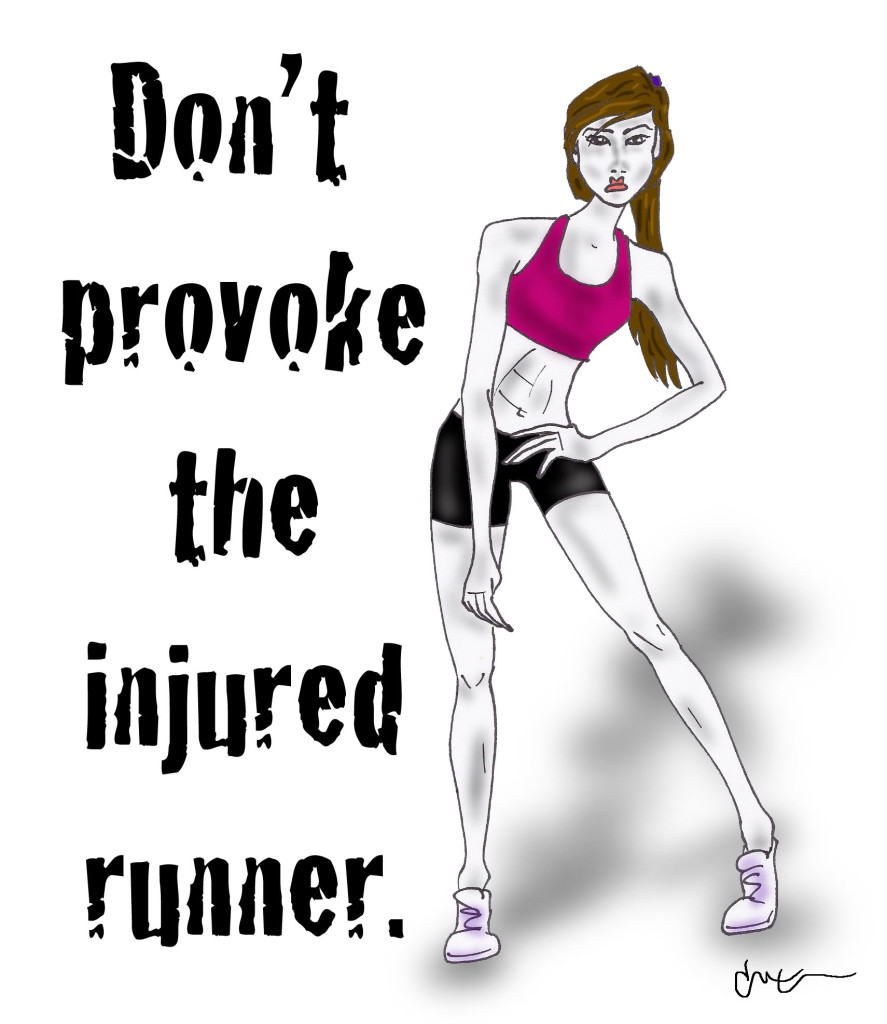
Now, the WORST and most common reasons for getting stuck in the black hole of injury cycles are…
NOT FIXING A RUNNING WEAKNESS!! Ding, ding. I’ll tell you what you’ve won…an ongoing issue that your body is continually compensating for. The muscles stuck working overtime to cover that compensating are causing your injures.
Since you never fixed the underlying issues, no amount of icing the injury or rest will keep you from getting injured again. The injury is the symptom…not the problem.
What’s My Weakness?
Hey, I’m a Weak Butt: Everyone is different, but there are FIVE top culprits for runners getting injured. Weak glutes, hamstrings, hips, back, and ankles. I wrote a post HERE highlighting each one specifically as well as exercises to help fix that issue.
I’m a Tight Runner: Tied into weak muscles are also muscles that are so inflexible they’re tugging and pulling on every other muscle. Being inflexible is setting you up for injuries, and the bad news is the older you get the harder it is to ‘undo’ that inflexible nature. It’s possible, you just have to keep working at it! The other bad news, for those who DON’T embrace stretching…the older you get the more injuries you’ll get because of it. So stretch…I wrote a whole post HERE all about my journey to becoming a pretzel person. 

I brought it up so I HAD to post it. ;)
The tricky thing with injuries is that the body is an interconnected machine…you could be struggling with a foot problem that is traced all the way to weaknesses in your hips! Crazy, huh? So it can be a bit of a Sherlock Running Holmes investigation to figure out the root of your injury, but the best places to start are the most common weaknesses, get strong there, rule them out, and see if you’re getting better. Here’s a post on my little ‘Injury from Whaaaa?” moment.
On a bit of a related note, bad form can also be an indication for where you are weak. A runner’s form breaks down as they tire, the more tired you get the more your body isn’t ‘thinking’ and slips into whatever ingrained habits it has. Usually your weaknesses will be apparent. Hey, another reason to fix those form mistakes, right?!  Read some tips on that HERE.
Read some tips on that HERE.
So we said the dreaded I-Word about a bizzillion times in this post. Thankfully running injuries aren’t like Bloody Mary or The Candy Man, we don’t conjure them up by saying their name. It’s kinda worse, because they come about while we’re doing something we love.
Stop injuries from visiting you again and again and again and again…and fix your weak spots! 
1) What’s been one injury cycle you were stuck in?
Hamstring, adductor, glute trifecta
2) How did you get out of the cycle? Or, what will you do to get out of it?
Getting my stretching on.
3) What’s been a stupid mistake, or klutzy move, you did to get injured?
Hmmm…klutz ball here, I’ve fallen a billion times.

.jpeg?picon=3498)
By: Cait,
on 1/24/2014
Blog:
Cait's Write...
(
Login to Add to MyJacketFlap)
JacketFlap tags:
running,
motivation,
art,
goals,
injuries,
intervals,
races,
facing fears,
race tips,
bad races,
Add a tag
Sometimes a runner’s already won the race before the gun’s even goes off. Questions. Doubts. Insecurities. None of these belong at the starting line; starting line of a race or a workout. A runner needs confidence. NEEDS it… no amount of physical endurance, speed, or fitness can make up for it.
How one steps to the line is what separates the GAMERS from the runners who perform at about the level they do in workouts, and then harriers who self-implode.

Confidence is a tricky one, it’s a mental factor of running and training. Once shaken, a runner’s confidence can be quite difficult to fully restore. Injuries, off days, strings of bad races, all of these plant seeds of doubt. Doubt is like a monster that, once you feed it, it grows exponentially in size. It’s a voracious monster that will eat a runner whole. Step to the starting line enveloped in that ugly monster and you might as well not even wait for the gun to crack. You’re already a dead runner ‘running’.
By the time you step to the starting line, there is NOTHING you can change about the past. Stop any questions of, “Should I have done…?”, “Did I do enough…?”, etc. You can’t do it, so no use worrying about it.
Don’t let that scare you off, if you’ve got some doubts, that’s only natural. And if you’re currently fighting from falling into the pit with that ugly doubting monster, THERE IS still hope for you yet. It works two ways. You CAN restore your confidence. You CAN still step to the line a gamer. It just takes some work and shifting your thinking.
Usually doubts start from one of two places:
1) An Event: Events would be after injuries, poor performances, etc…it starts with a legitimate reason to question if your fitness is off and snowballs. Usually the first race or workouts back after an injury a runner naturally goes in with a little more trepidation. You need some solid performances under you belt to steamroll that confidence train back.
To help BOOST that train, remember that your talent and fitness never goes away. Your first race back may not be your PR, but trust in the process, trust in your dedication, and trust that you’re only going to improve from here.
2) Anxiety and Stress: Anxiety and stress tend to spike around pre-race time. I wrote whole posts HERE and HERE on how to use those nerves to your advantage. If you let too much pressure, internal and external, load you up, it’s like running with a weight vest. To help unload that pressure, usually it takes the runner looking within THEMSELVES and finding that passion and love for running that brought them to the sport. If they can get back the excitement and joy for just running, eventually the times, workouts, and races will get back on track.
Ironically, the LESS you think about races and workouts, typically the better you’ll do.
Remember that NO race is the last race in the world. Yes, it can be a Championship race or a PR you’ve been wanting to pop FOREVER…but know that tomorrow will always come and another race will too.
1) Where do you draw your confidence from before a race?
2) How do you use a race day atmosphere to BOOST your performance compared to regular workouts?
3) Have you ever had a time when your confidence was shaken, how did you get it back?

Trust me, there is something special about those endorphins…more powerful than even speed goggles. EVERYTHING just looks and feels better with a brain full of post-run endorphins. Those problems feel just a smidgen less monstrously terrible, food tastes better, even that neighbor you hate is slightly more tolerable. The world is just a better place after you’ve got your run on.
Now, certainly endorphins have a shelf-life…gosh, dang it! The answer though is simple…get up, run, get your endorphin shot, go to bed, repeat.
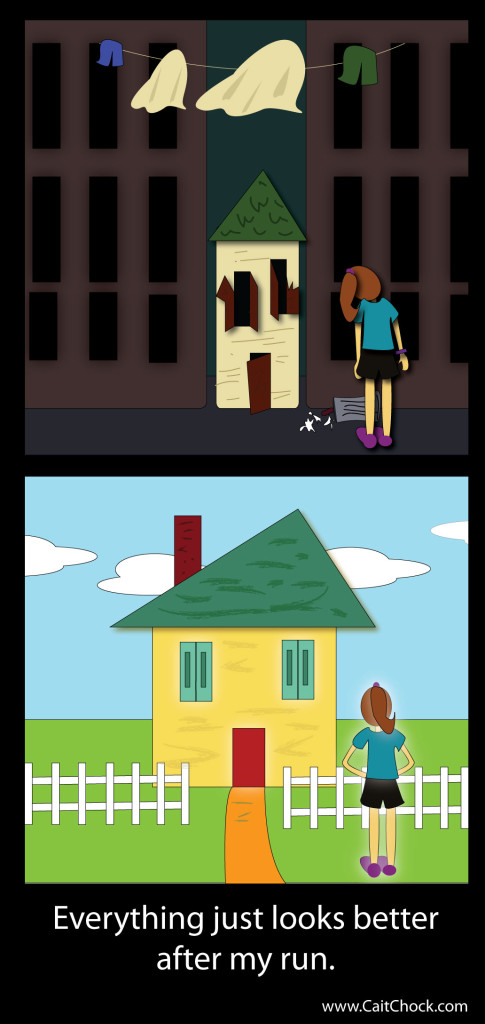
Living the life of a runner is like being in one of those revolving doors. It’s not a stagnate state, it’s ALWAYS moving. Tomorrow wipes the slate clean, and you have to start that run all over again. Some people could see that as a negative, “Dangit, I worked by butt off yesterday but when I go to bed I’ve gotta get up and do it all over again.”
Wiped clean, but not erased. Let’s look at the many positives of living in the running revolving door:
* Injures pass:
Stuck in the middle of an injury it kinda feels like that door is stalling out…maybe it’s broken and you’re trapped in injury purgatory FOREVER. But time passes,
injuries heal, and eventually you get back to your runs. Then savor them.
* Training accumulates: When tomorrow wipes the slate clean, it HARDLY erases all that hard work put in. This is the beauty of training cycles, the runs and hard workouts build upon the next, so that revolving door is more like an escalator. Riiiiide it, baby. BUT…it only goes up if you stay consistent in moving through those doors, you have to
be consistent with your running and putting in the work.
* Bad races are wiped away: There will always be days that bring you
bad races and horrible workouts. Can’t avoid them, the good news is you can LEARN from every off performance and after that, shake off the crappy run and get moving towards the next AWESOME run.
* ALWAYS another opportunity: Perhaps the most wonderful and motivating part of the revolving door is that there is ALWAYS another run, race, day, workout, waiting. So even in the most down times of your running, take a shower and set your sights on tomorrow. And the tomorrow after that…and just keep running.
So if you’re reading this in brilliant HI-DEF, magni-color vision…you must have gotten back from your run. If the world is looking a little grey, though, you know what you need to do…
1) List another benefit of tomorrow always ‘wiping’ away yesterday.
2) Name another major perk of endorphins?
3) Last lesson you learned from a bad day?

Running as an underdog rocks. Being an unknown is easy, and it’s just as fun to shock people. But shock wears off and then expectations can start to build. The thing is, EVERYONE has failures, set-backs, off-days and that’s when the critics start. The underestimating.
Dealing with nay-sayers comes in running and it comes in life. The thing is, you can USE those crappy words to your advantage. Let them underestimate you, let them think you’re not capable.

The times you get into trouble are when you start to doubt YOURSELF. Everyone have doubts, those moments of weakness, but the key to keeping those moments fleeting is by looking within yourself and believing. Believe in your abilities and your goals. Much easier said than done, certainly…kind of like saying running is just putting one foot in front of the other and then go really fast.
The mind is quite tricky, it can fool you into believing you can’t. But you can also fool IT…it’s all in how you think of it. Confidence comes in waves and it’s malleable; to get to the point of BELIEVING in yourself you sometimes just need to fake it ’til you make it.
Everyone has doubts, the people who achieve their goals do two things:
1) They set goals with passion. It has to REALLLLY mean something to you, because you’ll have to work your @$$ off to reach them.
2) They refute their doubts. When you catch your mind slipping, “I don’t think I can do this” you need to refute that, “H*ll yes, I’m doing this!” It’s not a question.
Of course goals can change, and there is a difference between being totally delusional and just confident in yourself. Certainly. Sometimes you have to be flexible and wise enough to know when the current course for your goals isn’t working and THEN you adjust. Just like with a training program, you need enough flexibility to know when to change the workout, tweak the plan.
But with confidence, you can’t let others shake you. In fact, once they start to underestimate you and your abilities…you’ve once again become the underdog, do you not? And everyone knows being an underdog rocks! 
———-
Confidence at the starting line of a race or workout is imperative, read my post HERE on how to be a gamer.
Sometimes expectations feel like pressure, but they shouldn’t. THIS POST is all about handing pressure.
Posts on how to set goals with meaning HERE
———-
1) When has been a time that you’ve been an underdog?
2) When was the last time you’ve dealt with nay-sayers? How did you prove them wrong?
3) When you’re having a ‘low confidence’ moment, how do you push to refute your doubts and believe in yourself?
Honestly, it’s SUPER hard, and everyone struggles. You refute even when you don’t believe it in the moment, and it’s okay to seek out the support of others who believe in you. And in those ‘lows’ remember that your confidence comes in waves and you need to just make it to that next ‘high’.

I love running (duh) but you may recall I’m not entirely in a Ménage à trois with stretching AND running. Don’t get be wrong, I KNOW how important regular stretching is to prevent injuries and improve your running performance. Heck, I write about it tons HERE and HERE…oh and I harp on it in my Competitor and Running Time articles.
But do I love it? Eh…we’ll say I would choke it down.
Then the world shook. You probably felt it actually. Remember THIS post where I talked about the BEST MASSAGE THERAPIST in the world?? Al Kupczak (aka also my BFF) literally solved a string of 3.5+ years of injuries stemming from my car accident. Side-not, getting hit by a car and almost losing your leg isn’t all it’s cracked up to be.
Well I mean I was able to run…but it was ugly, it never really felt like it used to, I couldn’t go faster than an easy pace without getting injured to where I couldn’t run at all. I saw lots of docs, tried lots of things…yada yada yada…finally got my butt up to Boulder, CO.
“Cait, you’re tight as h*ll.”
“I know, Al.”
“It’s not all your fault, there’s lots of scar tissue and calcifications stopping you from being able to stretch.”
“I’ve been TELLING PEOPLE!!! See, it’s not my fault, stretching doesn’t like me!!”
“Well now that I’ve broken all that up you CAN stretch now.”
[not verbatim but you got the gist]
It was an intense 12 days, saw Al Kup every other day for 2 hours at a time but…miracle beyond miracles check this out:

First day in CO…I’ve never IN MY LIFE touched my toes before.
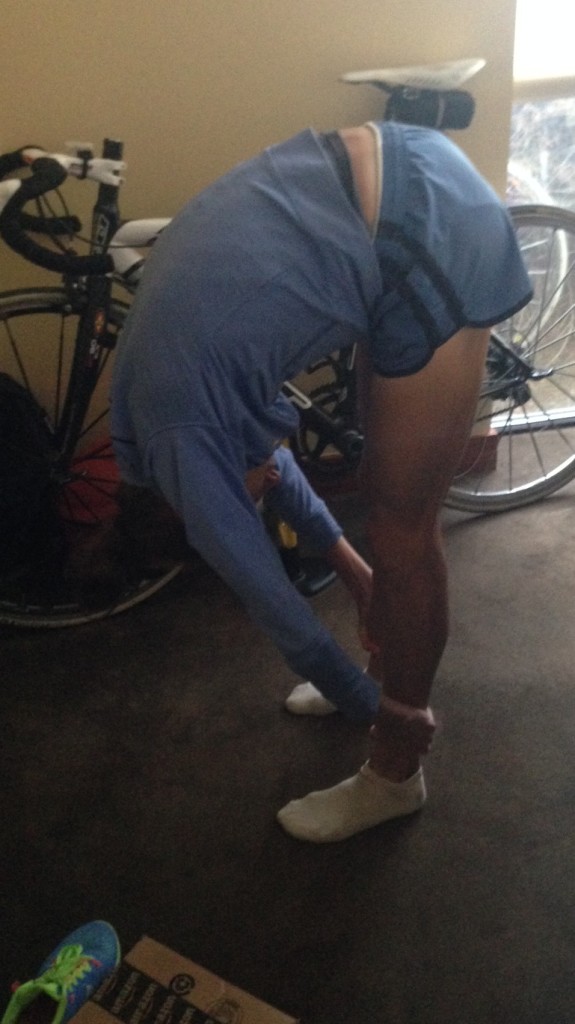
This is only four days later after 2 treatments. I was able to touch the ground and even grab my ankles and pull myself closer to my thighs. [yes I'm wearing the same scrubby runner shorts, don't judges. I had to pack light...it's called rinse, hang, and repeat  ]
]
I had a lot of issues but the main ones were my hamstrings, adductors, and abductors. They were extremely tight and in a constant tug-of-war when I ran. When I left CO, Al sent me home with a bunch of stretches and some lovly parting words, “If you want to stay healthy you have to keep stretching.”
So I’ve been religious about my stretching routine.

I had to touch my toes to take that first shot!! Booyah! ;)
#proof
Now I want to also tell people that when you have a TON of issues [like I did, Al had a lot to work on, and fixed a pretty marked leg length difference] and you make changes, even ones for the better, your body is thrown for a loop. It takes time to adjust to the new running style.
Think about it, you do something one way for years and years, it will take time for the body to adapt. There will be weaker muscles not used to working as hard that need to get stronger and to avoid compensation injuries you’ve got to be careful.
So my new runner body IS going through lots of changes, sorenesses and tightnesses I’ve never had before. I call Al freaking out but his answer is always the same: “Stretch. Be patient.” He’ll give me the best stretches for the specific soreness and I am always amazed that *viola* a few days later the sorenesses are gone.
The world has been flipped upside down. I actually AM embracing a three-way with running and stretching. And I certainly hope you do too…preferably it’ll take you SOONER than I did to open up to the miracle of the stretch. 
Side-note here…this Arty Runnerchick is FINALLY on instagram!! You can check me out HERE…and see my very first picture. Awww…sooo cute…like a baby taking their first steps, except I’m a fully grown adult who was too lame to get on the site at a decent age. PS- I’m an artist, I post my art my choice…so don’t worry there will not be tons of selfies 
——
In case you missed it…check out my NEWEST running shirt!
——
1) Do you stretch often?
2) Do you actually LIKE to stretch?
3) Are you on instgram?? Let me know!!

Not that us distance runners are necessarily forgetful, but there are some thing we tend to lose sight going about our routines. Hopefully it’s not showering altogether…but totally no judgement if you’re still sitting in this morning’s runner clothes. 
So just in case your distance runner logic is a tad skewed and you need someone else to remind you of these things…
1) “That’ll do, Pig.”
Sorry I could NOT resist the Babe reference, every time I hear ‘that’ll do’ my mind finishes it with Pig. For all those who don’t know what I’m talking about, I’m not calling you guys pigs, I really mean “That’ll do, Runner.” Distance runners are NOTORIOUSLY the hardest on themselves, it’s that kind of type-A personality trait that can push us to be the best or be our own worst enemy.

Every now and again a runner needs to hear that they did a good job. That they HAVE worked hard enough, that they ARE mentally tough enough. All of that. Here is one reason why I always recommend runners have a [GOOD!] coach, to get that outside perspective. After a crummy race, rather than instantly jumping to, “Dang, I SUCKED! I must have been a mental weenie today…ugh.” Just stop it and be productive, “Okay, that was rough. Did I give it my all? Can I learn anything from this to do better next time? Take those answers and do with them what you will. But treat your runnerself with some kindness, mmmmk?
2) “This injury WILL end.”
In the midst of an injury it’s way too easy to jump straight to cataclysmic-mode, “I’m going to be injured FOREVER!!! FFFOOOORRREEEEVER!!!” [How many movie references can I sneak in here, right?] It can be hard to even imagine a day where you won’t be in pain. But…
…every injury WILL eventually get better. It will take time, but it will heal. So stay productive and do your cross-training but ALSO look into the source of your injury. Most often they come about because of a muscle imbalance, weakness, or compensation issue; the actual injury is merely a symptom of that. Correct the source during that time so you don’t have to wind up with the same injury again and again.

3) “You love to run.”
Bam…way to many people wind up burned out just because they have sucked the love and joy out of their running. Don’t worry, that passion can come back, but if you find yourself dreading your runs, what the heck is the point of that?! Even professional distance runners preserve their passion for running.
Running is way too ‘punishing’ a sport to force down anyone’s throat. If you’re not having fun with it, ask yourself why you’re doing it? Get the joy back in your running, and here’s my post on THAT. [Being burned out is different than those 'meh' days when your motivation is in a lull...tips for beating that HERE.]
BONUS!! Look at me, I’m just so giving.  4) Consistency trumps all.
4) Consistency trumps all.
There really is no secret to success or getting better at running. It comes from being consistent. Yes, speed workouts will make you faster, but there is no magic bullet…running hinges on consistently putting in the work. You gotta want it, right?!
1) Can you name my second movie reference?
2) What’s something you feel every runner needs to be told, and re-told again and again?
3) How do you preserve the passion with your running?

Far too often we take things for granted. You wake up feeling ‘meh’, the run for the day not looking like the most appealing option. I mean running was there for you yesterday, in today’s motivation lull you assume you can blow it off today and running will still be waiting for you tomorrow.
It happens with everything, the random lamp in the house that’s just always been there. You don’t even notice it anymore. It just blends right in, ignored, the act of flipping the switch an unconscious act. You don’t even REALLY care about the lamp, say, until the power goes out. You flip the switch and suddenly think, “WTF?!?!” Taken for granted.

Another ‘WTF’ moment, right? 
Never treat your running like a stupid, random lamp. I was having my own ‘meh’ moment not too long ago. I was about 1 minute into my run, forced myself to at least that point, but the endorphins had yet to really kick in, you know?
Then I passed a house where a man in a wheelchair was working to get himself into a car. He didn’t have legs from the knee-down.
BAM…it hit me, I was too lucky to be feeling ‘meh’ about my running. I was so freaking lucky I COULD use my two legs in such a way. On my way back home I ran past the man’s house; he wasn’t there, but his car was. I could see the wheelchair lift rack in the back. Now every time I run past that black van I say a thanks to my two, whole legs. I remember to be grateful I am able to use them in suck a way and run.
Don’t feel guilty about your own ‘meh’ moments. Runnerchicks and runnerdudes, we ALL get them. Feeling complacent versus lovey-dovey and excited towards your runs go in spikes and drops. Talk to the runner who just came off of a 3 month injury and they’ll pledge to NEVER take their running for granted ever again. Find them 6 months later, a full stretch sans injuries, and certainly their ‘meh’ days are back.

I was lucky to get my reminder to kick that ‘meh’ feeling in the butt from an indirect source rather than having an injury of my own force me into missing my running fix. That’s not always the case…if you’re not injured right now and able to run, you’re lucky.
Runners, let’s take a moment to collectively celebrate what we do. Be grateful for this insane addiction to running and that we have the option to lace up and head out. I speak to all, those injured too, because those moments are some of the toughest, most crushing, and heart-breaking. If you’re not a runner that sounds way overly-dramatic, but all runners ‘get’ how hard injuries are on the psyche.
Unitedly, we’re sending positive vibes and supportive thoughts to YOU, the injured runner populous. We also send the message of: “Hang on, you’ll get back there. Take it one day at a time, do your rehab, and as sick as it sounds be grateful for your cross-training. It will get you back to running and still offers an, albeit much weaker, endorphin fix. Just hang on.”
So, Runners, if you are feeling ‘meh’ right now cut the crap: lace up, head out, and pick a moment to smile on your run. [if it's a hard workout it's okay if the smile looks like a twisted, ugly, grimace...then do a real smile after the end of those intervals.  ]
]
1) When was your last injury?
2) When was your last ‘meh’ moment?
3) What happened; if you blew off your run what did you do instead? If you did run what mental motivation trick did you do to get out the door?

One of the trickiest things about running is it’s wrought with ambiguities. So many fine lines: how hard is too hard, what is too easy, when to push rather than pull-back, and differentiating between what kind of pain requires you to put your big girl/boy pants on and suck it up versus the kind of pain where you need to stop. That’s not even the full list of running ambiguities.
For a runner that’s training, in order to improve there are plenty of times where it just plain hurts. Part of training becomes callousing your mind to that pain, using mental tricks to dull the complaints from your mind and muscles, and getting used to the discomfort. But then we also are told of the importance of easy days, recognizing the signs of burn-out, or days when the legs just don’t show up and the workout needs to be adjusted.

All this is enough to make your brain run in circles!
Catch that pain early enough and you could avoid a chunk of time off and lost training, or push through that pain, keep running, and wind up going until you’re literally broken.
The conundrum only goes further as no one can really EXPLAIN all these wrong pains and fine lines. Tired versus lazy, too easy versus too hard, etc. because everyone interprets pain differently and has a different pain threshold. When one runner says their leg hurts, depending on the person that could mean their calf is sore or their hamstring was torn and it’s balled up down near their knee.
Sometimes a runner needs a swiftkick in the butt, other times a runner faces an even harder reality and they need to cut themselves a break. Get doing this running business long enough and the word ‘day off’ reads as a death sentence.
Times for the Kick in the Pants VS. the Death Sentence (aka when a runner needs to ease up):
* Tough Love: It’s just a day where you’re feeling ‘meh’. You’re tired, you’d rather sit down, go out with your friends, the run just isn’t the most enticing thing. Motivation lulls happen, TIPS HERE, you just have to lace up and get going. The first mile will be the hardest, then you get into it.
* Corny Tender Lovin’ Care: It’s been a string of days where you feel ‘meh’. Your legs are more than tired, they’re heavy…every.single.time.out. Time to assess your training, your workouts, health, etc. What’s up? Are you digging yourself a hole?
* Tough Love: The workout for the day plain scares you. The first mistake is dwelling on that fear; it’s even risky admitting to yourself you’re scared of it. NEVER out-think yourself from a workout before you even start. Be confident in yourself, but sometimes you need to just fake that confidence, every runner does that too…but they don’t tell you. The pain, times, workouts can be scary if you really think about them…so you don’t. We play the ignorance is bliss card and just START. Then take everything as it comes.
* Corny TLC: You’re running the workout and the times are horrible, like deplorable. The conditions are just as heinous, you feel like you’re running on the sun, or into a headwind, or through a snowstorm. Don’t take the times at face value here, go off of effort. Numbers can’t tell the whole story, and if you start berating yourself for the slow times then you’ll wind up sandbagging the workout and not getting the benefit. It comes down to EFFORT…conditions are not an excuse, they really do affect the times. Still put in the effort, and the workout will give you the benefits intended.
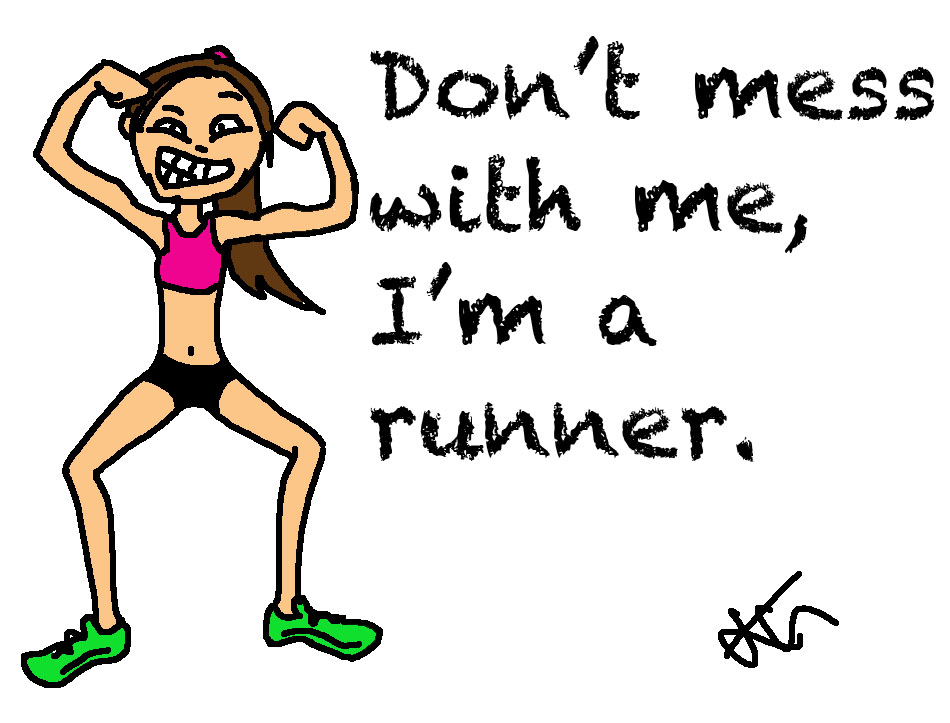
Runners are tough…sometimes TOO tough.
You just got passed in a race. Rather than let your mind tell you, “Welp, we’re tired anyways, so who cares…let them go.” You need to FIGHT. Leach onto that runner, get right on their butt, and use them to tow you along…tuck in. A race isn’t over until you cross the line; you can
gather energy behind them and surge later.
* MAJOR Corny TLC: Bam…you’re running and you step wrong, your quad lights up. You know that pain…a mile later and the pain hasn’t diminished. You’re tempted, “It’s okay, I know I can just finish this workout, I can get through it.” But that knot in your stomach knows the truth; if you push it until the end of the run you’ll probably be limping all day, if walking at all. Rather than running until you’re broken, be SMART and STOP. Hit up the
injury rehab and cross-training for a little while now, rather than being chained to the da** cross-trainer for months.
Good pain, bad pain? Too hard, too easy? So many lines, so many ambiguities, so many decisions to be made on the fly. The longer you run though, the better you get at recognizing the differences and when you need a kick in the pants versus cutting yourself a *gasp* break.
1) What’s a time when a runner needs the kick in the pants?
2) Give an example of when some corny TLC is in order?
3) Lessons are often learned the hard way, share a story of a lesson you learned as such.

The longer that you’re a runner the more time it takes to keep yourself healthy to run. I know I’m not the only one with a laundry list of to-do’s to keep this creaky body on this side of moving. Soon it becomes that the time you actually spend running is outpaced by the outside ‘extra’ work you do to keep you running!

Don’t make this you.
My latest article up on
Competitor: “3 Things Under 5 Minutes Every Runner Should Do Daily” explains the importance of including
these strength, flexibility, and
injury-preventative work into your day. But let’s be straight-up, lots of people have lives and getting the time to just RUN is pushing it. (I’m boring and don’t really have a life, juuust kidding…I have to work and pay ‘dem bills too, bummer. And I think I still have one or two friends rolling around this green Earth.)
But I’m betting you can find a spare 5 minutes SOMEWHERE during the day…waiting in line at Starbucks could take longer. Am I asking you to bust out some planks right there in line? If you do and take a picture of you rocking the core routine in line I’ll totally post it, so send it my way!
Injury issues aside, getting a stronger core and increasing your flexibility will translate into running faster too. Get stronger = Get more efficient = Get faster. I harp on that enough around the blog too.
The self-massage part of the injury prevention is also really important, it gets more-so the longer we run too. I may be 27 but I’m strapped in the body of a geriatric, I’ll probably be rascal-bound by 30…but I’ll take getting my miles fix up until I’m legless. I wish I could afford a professional massage therapist on my ‘staff’, but I’m not there yet and most other people are in the same boat.

In reading the article, I want to follow-up here with just HOW important it is that you know what you’re doing before you go digging around on yourself. You can make injuries worse and cause injuries if you’re not careful. Here are our self-massage rules of the road:
1) Ease into it: Just like you need your muscles warm before you stretch, make sure you’re not massaging cold muscles. Likening your pressure to stretching again, start with gentler strokes and gradually increase the amount of pressure. Your muscles will FREEZE-UP if you go in like a wrecking ball right away. [One guess what song was stuck in my head earlier.]
2) 5-10 Minutes: Limit the amount of time you spend on each area of your runner bod to only 5-10 minutes. You don’t want to go over-board.
3) Cross-Wise Passes: I have tons of hamstring issues, when I’ve got a sore spot I rub cross-wise over the area first and finish up with some flushing lengthwise passes. Don’t forget the horizontal plane, rub side-to-side and then move to the foam roller.
4) Wait 24: The most common time runners self-massage their way to worsening an injury is when they get a new soreness, freak out it’ll be an injury, then go to town massaging and stretching like a madman. This is NOT what you should do. If the pain is so bad it’s tender to the touch, wait a day to let things simmer down. Go the icing route. After that, be gentle, don’t go until you’re about to cry. Refer back to steps 1 and 2. You can self-massage yourself away from an injury if you do it right and are smart.
5) Consistency: Just like you can’t expect to PR running one day every third Tuesday, self-massage works best when you’re consistent. In fact, if you’re spooning (just kidding) spending time with your foam roller daily, you get to the point where it DOESN’T bring you near tears…miraculous, I know. 
Until we’re Lady Gaga rich, let’s self-massage ourselves, Runners, to stay healthy. Even just 5 minutes a day. Hey, triple points to the person who walks into Starbucks with their foam roller under their arm! 
1) Will you commit to doing at least 5 minutes of some core/flex/self-massage work I talked about in my article?
2) Who is consistent with their self-massage and foam rolling?
3) Did you learn some kind of nugget of wisdom from my bloggy-blabberings?

View Next 8 Posts
 Levine, Kristin. 2014. The Paper Cowboy. New York: Putnam.
Levine, Kristin. 2014. The Paper Cowboy. New York: Putnam.











































